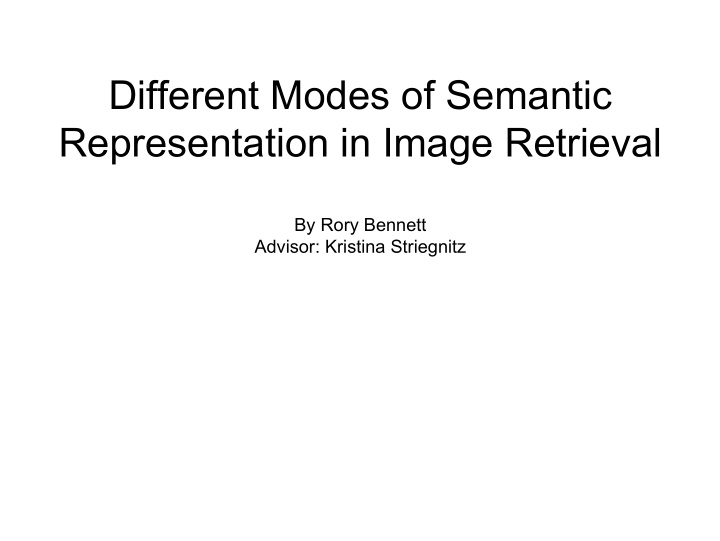



Different Modes of Semantic Representation in Image Retrieval By Rory Bennett Advisor: Kristina Striegnitz
Image Retrieval dog war
Concreteness & Imageability Abstract(less concrete), less Concrete, less imageable: concept imageable: argue Abstract, more Concrete, more imageable: plead imageable:
Text-based Image Retrieval (TBIR) Text-based dog; kiss image retrieval system Images with captions This woman is giving her dog a kiss
Text-based Image Retrieval (TBIR) Text-based dog; kiss image retrieval system Images with captions This woman is giving her dog a kiss love; war ???
Retrieval Based on Word Similarity Text-based elegant image retrieval system Image database The tuxedo is the perfect Word formal garb. comparison technique Words returned by comparison technique, that also tag images
Semantic Vector Representations elegant : [-0.081428, 0.102486, -0.198815 , -0.145852 , -0.148051, …] tuxedo : [-0.116671, -0.163012, -0.094523, -0.108007, 0.084851, …] fear : [0.121500, -0.413079, -0.040310, 0.113604, -0.353846, …] Sample Text elegant tuxedo elegant fear elegant tuxedo
Semantic Vector Representations (cont.) - All vectors are mapped to a common vector space, to compare vector cosines and thus find words with similar meanings elegant y majestic a tuxedo swan b chocolate fear x *a, b represent cosine distances between semantic vectors
Vector Comparison, Approach A Entire Image Dataset Image 1 Semantic Caption word 1 . Vector 1 . Caption word 2 . . . Normalized . . . average . semantic Caption word k vector . Semantic . Vector k Image n Vector comparison Query term’s semantic Query term vector
Vector Comparison, Approach B Images directly tagged by words most similar to query term Image 1 Semantic Caption word 1 . Vector 1 . Caption word 2 . . Normalized . . . average Image i . semantic . vector Caption word k Semantic . Vector k . Image n Vector comparison Query term’s Query term semantic vector
Abstract Words’ Meanings Encapsulate Concrete Words’ Meanings ● Lawrence W. Barsalou, Katja Wiemer-Hastings: abstract terms provide more general, overarching descriptions of images related to concrete terms ● Google query for abstract term, “love”:
Augmenting Textual Data With Perceptual Information ● Felix Hill and Anna Korhonen used the Text8 textual corpus, and perceptual datasets comprising captioned images and feature-annotations of cue words. Text Corpus Images with The dog sits happily on the porch ... captions . . . . dog , fur , tail , kibble , ... . Insert words . into text corpus .
Experiment – Five Approaches - Retrieve images directly tagged by query term - Apply Approach A on plain Text8 corpus - Apply Approach B on plain Text8 - Apply Approach A on augmented Text8 - Apply Approach B on augmented Text8
Experiment – Query Terms Less concrete, less imageable nouns Less concrete, more imageable nouns More concrete, less imageable nouns More concrete, more imageable nouns Less concrete, less imageable verbs Less concrete, more imageable verbs More concrete, less imageable verbs More concrete, more imageable verbs
Experiment – Results, Part I
Results – Part II
Results – Part III
Conclusions - Utilizing perceptual information to form semantic vectors does not significantly inhibit, and can actually improve, the relevance of returned images. - There is at least some (if insignificant) increase in the relevance of retrieved images when switching from applying Approach A to applying Approach B for a single textual corpus. - If we assume that results from direct tagging are ideal, regardless of their paucity, then this indicates that including perceptual data brings retrieval closer to this ideal
Future Work - Focus on vector representations for words whose part of speech is typically very abstract, e.g. , adverbs - Better account for representation words with multiple diverse meanings
Recommend
More recommend